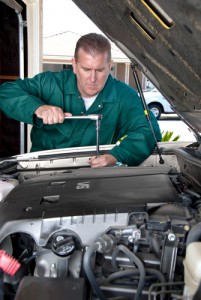Tire failure causes 11,000 car crashes a year, according to the National Highway Traffic Safety Administration. Cars driving on tires underinflated more than 25 percent are three times more likely to crash, and low tires are also more likely to overheat, NHTSA research shows.
This illustrates just one of the common safety issues that can result from improper vehicle maintenance. Eighty-four percent of vehicles need servicing or parts replacement for issues such as worn tires, low brake fluid, bad lights and engine issues, a Car Care Council survey found. Doing regular routine maintenance checkups on your car can help keep your vehicle in good shape and keep you and your family safe.
Tires
NHTSA studies have found that not only low air pressure but also shallow tread depth can increase both crash and rollover risk. To prevent this, you should regularly inspect your sidewalls for nicks and bulges, inflate your tires to the recommended level, and check your tread depth. The minimum legal depth for most states is 2/32 inches, but Tire Rack research has found that stopping time and bad weather performance deteriorate after tires reach 4/32 inches of remaining tread depth. Check your tires at least once a month as well as before you drive on a long trip, and replace your tires at least once every decade.
Brakes
J.D. Power says you should replace your brakes if you see less than 1/4 inches of outside brake pad pressed against your wheel’s metal rotor when looking through your spokes. Another warning sign is if you hear a high-pitched screech when braking under normal conditions. (If your car has been sitting exposed to moisture for a while, you may hear a screech for the first few stops, but it should sound normal after that.)
Other signs are if your brakes show reduced responsiveness, if they sink towards the floor, if your vehicle pulls to one side when braking, or if braking causes grinding, growling or vibration. Brakes should always be checked at least once a year or every 10,000 miles.
Fluids
Your brake fluid is also vital to brake maintenance. Thirteen percent of cars have low brake fluid, the Car Care Council’s survey found. Experts recommend checking your brake fluid every one or two years, according to AA1Car.com. You should also perform regular checks on your engine oil and coolant, power steering fluid and transmission fluid.
Signal and Lighting Systems
Checking your signals and lights is a simple maintenance task you should perform regularly. Make sure your front and rear turn signals are working, along with your rear hazard flashers. You should also check your brake lights, rear reverse lights, high and low beam headlights and side marker lights.
Electrical and Safety Components
Your electrical and safety systems should also be checked regularly. Make sure all of your dashboard and accessory lights work properly and no warning lights are on. In addition, check your seatbelts, horn, and child car seats if you have them.
Other Issues Under the Hood
Maintaining your fluid levels will go a long way toward maintaining your engine, but occasionally other engine issues may arise. Samarins.com recommends getting an engine tune-up every 60,000 to 90,000 miles or if you experience sluggish acceleration, low power, rough performance or misfiring.
Other problems under the hood may involve belts, hoses, filters, radiators, spark plug wires, or valves. For example, most valves use nitrile-based seals, which combine high fluid resistance with good compression, strength, and abrasion resistance. However, overheating can damage seals over time, causing lubrication or flooding problems. Popular Mechanics provides a step-by-step guide to running a compression test in order to check your valves and piston rings.
Ready for a New Ride or to Lower Those Existing Car Payments
Before that big adventure, make sure you are driving in style. If you are looking for a new or used car, be sure to check out the Auto Buying Service offered at OpenRoad Lending. There you can shop new and used car pricing in your area and find that car or truck of your dreams before hitting the highway. Maybe you don’t want a new vehicle but you are tired of paying too much on your existing auto loan… look no further than the auto refinance option at OpenRoad Lending. We are saving customers on average $100 per month on their car loan payments. It just takes a minute and the savings are well worth it.

